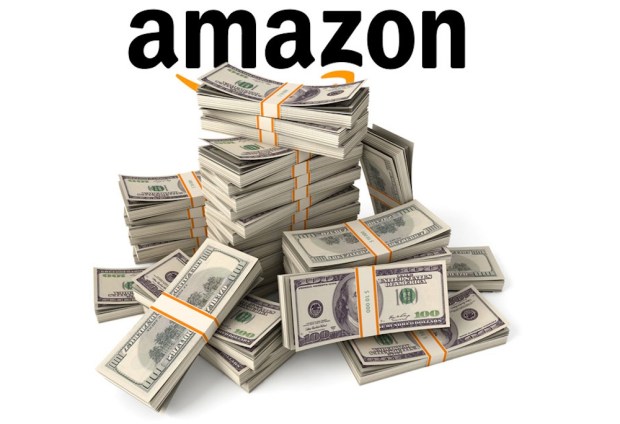Amazon Surges On Wall Street Beat

When it comes to reporting quarterly earnings, there’s beating Wall Street’s expectations, really beating them, and then there is what Amazon did yesterday.
Eight straight quarters of profits seem to have finally shaken off its reputation for being the world’s most successful company that failed to post a profit after 18 years in business.
It was a very profitable quarter, pushed by Amazon’s massive — and still growing (albeit more slowly) — web services business and a continued surge in the core eCommerce business. Amazon also managed to lower some of its operating costs, as it also saw an uptick in subscription and advertising revenue.
“So right now, we’re just seeing a lot of great opportunities before us. And we’re continuing to ramp up the investments in pursuit of those opportunities. And the big picture is, again, as we’ve said to customers — the things customers love can grow to be large; we’ll have strong financial returns, and they’re durable and can last for decades,” Amazon’s CFO Brian Olsavsky noted in his comments to investors after the earnings release, before rattling off the firm’s always extensive “What’s Next” list.
But before we get to what’s next, let’s close the door on this quarter.
By the Numbers
Amazon reported revenue of $35.7 billion this quarter, beating analyst estimates of $35.3 billion — a 23 percent increase from this time a year ago.
That was a beat — but the big beat was on earnings expectations. Wall Street got $1.48 per share and net income of $724 million — a 41 percent year-over-year increase.
Amazon Web Services (AWS) — the firm’s cash printing press that had attracted investor interest after slightly underperforming analyst expectations last quarter — also managed a beat, reporting $3.66 billion in revenue and 43 percent growth. The street had been looking for $3.65 billion on 42 percent growth. That aside, this does mark another quarter where the AWS speed of growth is slowing.The last three quarters, AWS grew by 47 percent, 55 percent and 58 percent respectively — impressive growth any way you cut it given their size and scale.
Sales in the eCommerce core business were up 23 percent year over year and retail subscription services (mostly Amazon Prime) were up 49 percent at $1.94 billion. Revenue from a co-branded credit card deal and from third-party sellers paying to promote their products on Amazon.com also rose 56 percent to $850 million.
“The core eCommerce segment remains very healthy,” said Colin Sebastian, an analyst at Baird Equity Research. “Subscription services and advertising are growing much faster and beginning to move the needle, which also helps increase profit margins.”
Amazon did have some losses to report — specifically, an operating loss of $481 million in its international segment. That is 4X more than a year ago this time — and largely attributable to the more than $5 billion Amazon has invested in India to gain market share, as well as associated expansion plans in Australia and Southeast Asia.
“A lot of the same playbook you’ve seen working in the U.S. is also being rolled out internationally,” Olsavsky noted on the costs — and long term efficiencies — of Amazon’s international efforts.
Amazon shares are up 51 percent in the past year. The company’s market cap is $439 billion.
It is forecasting sales for the second quarter between $35.25 billion and $37.75 billion.
Worth Watching
Investors did note some concern about the costs associated with Amazon’s international expansion — particularly in the increasingly competitive eCommerce segment. Olsavsky defended the move as important to Amazon’s long-term strategic vision, echoing a sentiment from CEO Jeff Bezos issued earlier in the day.
“Our India team is moving fast and delivering for customers and sellers. The team has increased Prime selection by 75 percent since launching the program nine months ago, increased fulfillment capacity for sellers by 26 percent already this year, announced 18 Indian Original TV series and just last week introduced a Fire TV Stick optimized for Indian customers with integrated voice search in English and Hindi,” Bezos noted.
Amazon also declined to break out any specific numbers about the costs or benefits in its hardware line, particularly in regards to Echo (and its associated AI Alexa).
“[Monetization] is not our primary issue right now. It’s about building great products and delighting customers. We think as engagement — as we pick up engagement with the devices — it helps the engagement with Amazon as a whole. So whether someone is ordering off their Alexa device or whether they’re going to their phone or going to their computer, it all has the same effect for us. So, very pleased with the initial progress. We see a lot of momentum there, and we continue to invest.”
Amazon also declined to break out specific figures associated with its expansion into physical retail — though they are, again, encouraged by the progress and hinting at further expansion in the future.
“We have six bookstores right now, and we have announced another six. The Amazon Go is in beta in Seattle, and while that’s not large and only one site, we’re excited about the potential there and the use of the technologies of computer vision, sensor fusion and deep learning. We think that has a lot of potential. Again, it’s only one location that’s still in beta. But along with the bookstores, we also have — you’ll see us in pop-up stores and college pickup points. So, for us, it’s another way to reach the customer and test what resonates with them, and we’re pleased with the results.”
Pleased with the results — and ready to move on the next project. It may have been a big quarter for Amazon, at least for outside observers, but Amazon is reacting the way it always does: by leveraging the momentum of its flywheel to capture more market share.
